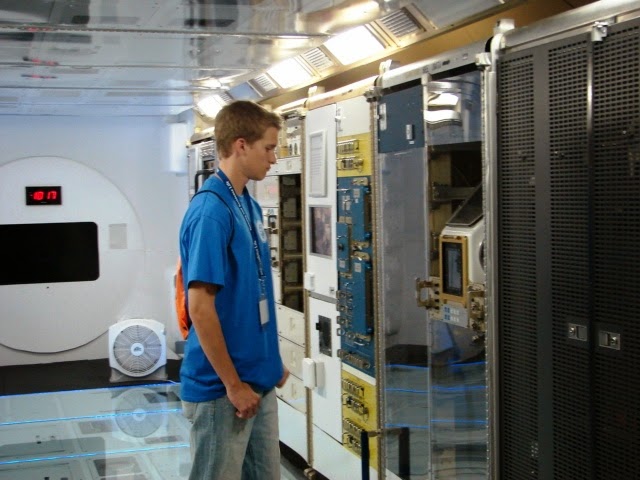The ISAS students got out of bed very early this morning to catch a 7:30 am flight to San Jose, California. From there they traveled to the location of the NASA Ames Research Center. At the Ames Center the students will be able to tour many of the testing facilities and scientific labs that have played a large role in bringing us the technology and scientific exploration known to us today. This is also one of the best opportunities in the academy to gain information in regards to their mission planning with many chances to speak with NASA professionals.
 |
| ISAS Students in front of one of NASA's wind Tunels. |
Students began their experience at NASA Ames at the visitor's center where they saw a model of inside the Space Station, a moon rock along with other NASA related missions in space. They also took an interactive tour of our solar system and beyond given by Don Richey with the IMAX like screen in the visitor center.
 |
| Students got to tour a space shuttle model at the NASA Ames' visitor's center |
Students then were able to tour the bioengineering lab with Mark Kliss. This lab is experimenting with recycling and cleaning the air and water on the ISS, along with finding a better way to contain trash and waste. This week's scholars asked questions about how they could apply those technologies on their mission to Mars. Students were able to get a glimpse behind the reasoning and methodology of NASA experiments.
 |
| Mark Kliss talks to the red and blue teams about the biology involved in space. |
 |
| Students take a picture with Astronaut Hall of Famer Karol "Bo" Bobco. |
Lynn Rothschild presented to our scholars on how to go about finding life on other planets. She recommended that the students first figure out what exactly they are trying to find: intelligent life, bacteria etc, because that dictates how you go about searching. The next step is discovering the limits of life on Earth. Then they would need to discover places similar to Earth out in space, including the extreme habitats here on earth. Finally they might try to create synthetic organisms that could exist in the more extreme space environments to see if it is possible for life to exist.
 |
| Talking about her work, Lynn Rothschild presents to the scholars on life off this planet. |
Students got to visit the First Robotics Lab at Ames. First Robotics is a global competition where participants build robots that have to compete in random teams of three in a different game every year. There are many robotic teams in Idaho and one of our students had even met the tour guide, Mark Leon, at a competition.
The final event of the day was a great time for the teams to take advantage of the fact they were on the site of a NASA center walking among elite scientists, engineers and other professionals. A panel of experts, including Mark Leon, Jake Forsberg, Greg Swanson, and Brian Day and two interns named Julia and Lauren brought over a sixty minute question and answer session to the students. Questions were asked such as, "Would a sky crane be an effective landing system?" “Should our drilling operations on Mars be manned or unmanned?” And, "Should we use the moon as a stepping stone in developmental plans to get to Mars?" To find out about the answers to these questions and to find out what decisions the teams made on the specific details of their missions, be sure to join us for the banquet on Saturday where the teams will present their final reports.
 |
| The student's got to pick the brains of these panelists. |
 |
| ISAS students asked very thoughtful questions, that our panel had fun answering. |
--Camille Eddy (ISAS 2012 alumna) and
Holly Palmer (ISAS 2013 alumna)
ISAS Social Media Mentors




Are you in search for the Are you in search for the Small Business Ideas with Small Investment? then here we present some of the best ideas by the experts to invest your money to turn into profitable business.
ReplyDeleteThese schools are really making it possible for the students to be eligible for NASA level education and I watch documentaries at maori television on demand, it keeps me attached to the TV all day long.
ReplyDelete